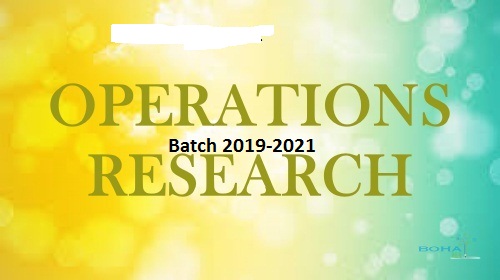
- Teacher: Dr. Johney Johnson .
- Teacher: Dr. Johney Johnson .
- Teacher: Faseela Ismail .
- Teacher: Dr. Mathew Kurian V
- Teacher: Dr. Johney Johnson .
- Teacher: Sri. Jacob N C
- Teacher: Dr. Johney Johnson .
- Teacher: Dr. Muraleedharan S.
The course is to introduce the language of economics and economic evaluation of the current policies and critical issues, of the health and education sectors of India in an inter-national perspective. The purpose of this course is to enable the students to examine the education and health systems with its markets from a structural perspective, identify the key economic issues relevant to policy, and evaluate the education and health programmes.

- Teacher: Dr. Johney Johnson .
- Teacher: Faseela Ismail .
- Teacher: Dr.Ajay M G
- Teacher: Dr. Johney Johnson .
- Teacher: Faseela Ismail .
- Teacher: Dr.Jose J Naduthotty
Operations Research
|
Course Name |
Operations Research |
|||||
|
Type of Course |
Elective |
|||||
|
Course Code |
KNM21E05 |
|||||
|
Course Summary & Justification |
Operations researchers focus on making specific decisions and economists study the consequences of different market structures and policies through an assumption of rational decision making. Both groups are interested in understanding rational decision making and the consequences of rational decisions. After successful completion of the course, students will be able to understand importance of optimization of industrial process management, apply basic concepts of mathematics to formulate an optimization problem and analyze and appreciate variety of performance measures for various optimization problems. |
|||||
|
Semester |
4 |
Credit |
4 |
|||
|
Total Student Learning Time (SLT) |
Learning Approach |
Lecture |
Tutorial |
Practical |
Others |
Total Learning Hours |
|
|
Virtual learning Collaborative learning Blended learning |
65 |
5 |
- |
50 |
120 |
|
Pre-requisite |
NIL As per the requirement of the course |
|||||
|
Others- Library, seminar and assignment preparations, tests. |
||||||
COURSE OUTCOMES (CO)
|
CO No. |
Expected Course Outcome |
Learning Domains |
PSO No. |
|
Upon completion of this course, students will be able to; |
|||
|
1 |
Identify and develop Operations Research models from the written description of the real system/situation. |
U,A |
5 |
|
2 |
Understand and apply the appropriate mathematical tools |
U, An |
5, 7 |
|
|
needed to solve optimization problems, involving the economic allocation of limited resources, by choosing a particular strategy to achieve the desired objectives. |
|
|
|
3 |
Formulate a given simplified description of a real-world problem as a linear programming model. Solve a 2-dimentional linear programming problem graphically and by Simplex method. |
C |
5,8 |
|
4 |
Propose the best strategy using decision making methods under uncertainty and game theory. |
E, C |
5,8 |
|
5 |
Apply linear programming in the area of physical distribution of goods/services from several origins to several destinations in a way to minimize the total cost of transportation. |
A |
5, 7 ,8 |
|
6 |
Apply Hungarian method to assign a number of resources to an equal number of activities so as to minimize total cost of maximize total profit of allocation. |
A |
5,7 |
|
7. |
Use Simulation techniques to experiment on a model of a real situation without incurring the costs of operating on the system. |
U,An,A |
5 |
|
8. |
Use CPM and PERT techniques, to plan, schedule and control project activities. |
U,An,A |
5 |
|
*Remember (R), Understand (U), Apply (A), Analyse (An), Evaluate (E), Create (C), Skill (S), Interest (I) and Appreciation (Ap) |
|||
COURSE CONTENT
|
|
Hrs |
CO.No. |
|
|
UNIT 1 – Introduction to Operations Research |
7 Hrs |
||
|
1.1 |
Operation Research approach, , history of Operations Research scientific methods. |
3 |
1 |
|
1.2 |
Introduction to models and modeling techniques - general methods for Operation Research models. |
2 |
1 |
|
1.3 |
Methodology and advantages of Operation Research |
2 |
1 |
|
UNIT 2 - Linear Programming (LP): |
16 Hrs |
||
|
2.1 |
Introduction to LP and formulation of Linear Programming problems |
4 |
2,3 |
|
2.2 |
Graphical solution method, alternative or multiple optimal solutions, Unbounded solutions, Infeasible solutions |
5 |
2,3 |
|
2.3 |
Maximization – Simplex Algorithm, Minimization – Simplex Algorithm using Big-M method, Two phase method |
5 |
2,3 |
|
2.4 |
Duality in linear programming, Integer linear programming. (An introduction to the concept) |
2 |
2,3 |
|
UNIT 3- Transportation & Assignment Problems: |
17 Hrs |
||
|
3.1 |
Introduction to Transportation problems |
2 |
1 |
|
3.2 |
Various methods of Transportation problem —North west corner rule, Least cost method, Vogel’s Approximation method |
3 |
5 |
|
3.3 |
Variations in Transportation problem—Unbalanced supply and demand, Degeneracy, Maximization transportation problem, Prohibited transportation routes. |
5 |
5 |
|
3.4 |
Introduction to Assignment problems—Hungarian Method |
4 |
6 |
|
3.5 |
Variations in Assignment problems –unbalanced assignment problem, Travelling salesman problem. |
3 |
6 |
|
UNIT 4 – Network Analysis |
14 Hrs |
||
|
4.1 |
Network definition and Network diagram |
3 |
8 |
|
4.2 |
Probability in PERT analysis |
3 |
8 |
|
4.3 |
Basic concept of Floats, Critical path method(CPM) |
3 |
8 |
|
4.4 |
Project time cost trade off—Crashing of a project |
4 |
8 |
|
4.5 |
Introduction to resource smoothing and allocation. |
1 |
8 |
|
UNIT 5 – Queuing Models: |
10 Hrs |
||
|
5.1 |
Concepts relating to queuing systems, basic elements of queuing model, role of Poisson & exponential distribution. |
2 |
2,4 |
|
5.2 |
Basic Concept of Simulation-- Monte Carlo Simulation |
3 |
7 |
|
5.3 |
Sequencing Problems |
2 |
2,4 |
|
5.4 |
Game theory: Saddle Point, Mixed strategy, Dominance Rule. |
3 |
2,4 |
|
Teaching and Learning Approach |
Classroom Procedure (Mode of transaction) Authentic learning, case-based learning, collaborative learning, seminar, group activities. |
|||
|
|
CD |
Course Delivery methods |
|
|
|
CD1 |
Lecture by use of board and online mode |
|||
|
CD2 |
Tutorials/Assignments |
|||
|
CD3 |
Seminars |
|||
|
CD4 |
Self-prepared instructional videos (during online mode) |
|||
|
CD5 |
Teaching aids ( videos from youtube) |
|||
|
CD6 |
NPTEL materials (MOOC) |
|||
|
|
||||
|
Assessment Types |
Mode of Assessment · Continuous Internal Assessment (CIA) · Seminar Presentation – Any topic which forms theoretical background is identified to prepare a paper and present in the seminar · Assignments · End Semester examination |
|||
|
|
Course Outcome |
Course Delivery Method |
|
|
|
CO 1 |
CD1 , CD 5 |
|||
|
CO 2 |
CD1, CD6 |
|||
|
CO 3 |
CD1, CD2, CD4, CD5, CD6 |
|||
|
CO 4 |
CD1, CD2, CD4, CD5, CD6 |
|||
|
CO 5 |
CD1, CD2, CD4, CD5, CD6 |
|||
|
CO 6 |
CD1, CD2, CD4, CD5, CD6 |
|||
|
CO 7 |
CD1, CD2, CD4, CD5, CD6 |
|||
|
CO 8 |
CD1, CD2, CD4, CD5, CD6 |
|||
References:
Text Books
1. Sydsaeter, Knut and Peter Hammond (2002) - Essential Mathematics for Economic Analysis, Prentice Hall: Harlow, England.
2. Yamane, Taro (1962) - Mathematics for Economists, Prentice Hall,
3. Allen, R.G.D (2008). - Mathematical Analysis for Economists, Macmillan Press, New Delhi.
4. Chiang, A.C (2005)- Fundamental Methods of Mathematical Economics, McGraw Hill, New York.
5. Handry, A.T (1995). - Operations Research, PHI, New Delhi.
6. J K Sharma, Operations Research Theory and Applications, MacMillan India Ltd.
7. N D Vohra, Quantitative Techniques in management, Tata McGraw Hill.

- Teacher: Dr. Johney Johnson .
- Teacher: Smt. Asha T A

- Teacher: Dr. Johney Johnson .
- Teacher: Faseela Ismail .
- Teacher: Dr.Ajay M G
- Teacher: Sri. Jacob N C
- Teacher: Dr.Jose J Naduthotty
- Teacher: Dr. Muraleedharan S.
- Teacher: Smt. Asha T A
- Teacher: Dr. Mathew Kurian V